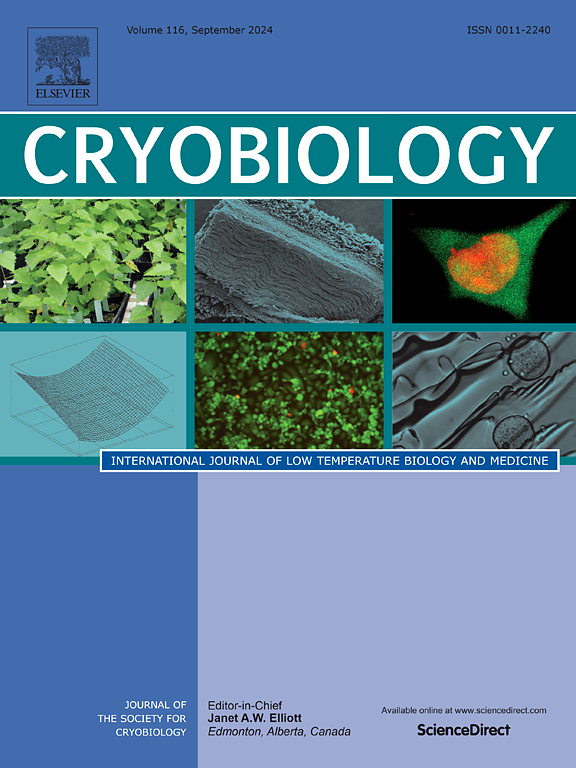Morphological characteristics, mitochondrial oxidoreductase activity, and vascularization of human adipose tissues pre-and post-xenotransplantation into BALB/c female nude mice
IF 2.1
3区 生物学
Q2 BIOLOGY
引用次数: 0
Abstract
This study aimed to evaluate the effect of different cryoprotectants on the histomorphological characteristics, oil ratio (OR) indices, mitochondrial oxidoreductase activities, and vascularization of human adipose tissues after thawing (pre-xenotransplantation), one month and three months post-xenotransplantation. For this purpose, we froze human adipose tissues in five experimental groups, including NCG (PBS without any cryoprotectants), FG1 (4 % DMSO+6 % Trehalose), FG2 (6 % Trehalose+2 % DMSO+9 % FBS), FG3 (2 % DMSO+4 % Trehalose+3 % Sucrose+9 % FBS), and FG4 (4 % DMSO+3 % Trehalose+3 % Sucrose) and compared them with the positive control group (PCG or fresh adipose tissue). Adipose tissues were frozen with a cooling rate of −1 °C/min and stored in a freezer at −20 °C until use. Three months after freezing, human adipose tissues were xenotransplanted into the BALB/c nude mice for one and three months. Then, xenografts were removed and evaluated for histopathological properties, OR indices, mitochondrial activities, and vascularization. After thawing (pre-xenotransplantation) and post-xenotransplantation (one- and three-month after xenografting), the NCG group demonstrated the most significant tissue damage including necrosis, multiple cysts, inflammatory cell invasion, cell rupture, fibrosis, necrosis and ECM disintegration (p ≤ 0.05). Pre-xenotransplantation, one- and three-month after grafting, the best structural integrity of adipose tissues with the least degeneration of adipocytes was detected in the FG2 and FG3 groups (p ≤ 0.05). Pre- and post-xenotransplantation, the highest and least OR indices and mitochondrial oxidoreductase activities were demonstrated in the NCG and FG2 groups, respectively (p ≤ 0.05). The least VEGF and CD31 expressions were shown in the NCG group at pre- and post-transplantation (p ≤ 0.05). The highest CD31 and VEGF expressions were detected in the FG3 and FG2 groups after thawing and grafting (both one- and three-month) (p ≤ 0.05).
BALB/c雌性裸鼠异种移植前后人脂肪组织的形态特征、线粒体氧化还原酶活性和血管化
本研究旨在评估不同冷冻保护剂对人脂肪组织解冻(异种移植前)、移植后1个月和3个月后组织形态学特征、油比(OR)指数、线粒体氧化还原酶活性和血管化的影响。为此,我们将人体脂肪组织冷冻成5个实验组,包括NCG(不含任何冷冻保护剂的PBS)、FG1 (4% DMSO+ 6%海藻糖)、FG2(6%海藻糖+ 2% DMSO+ 9% FBS)、FG3 (2% DMSO+ 4%海藻糖+ 3%蔗糖+ 9% FBS)和FG4 (4% DMSO+ 3%海藻糖+ 3%蔗糖),并与阳性对照组(PCG或新鲜脂肪组织)进行比较。将脂肪组织以- 1°C/min的冷却速度冷冻,并在- 20°C的冷冻室中保存直至使用。冷冻3个月后,将人脂肪组织异种移植到BALB/c裸鼠体内1个月和3个月。然后,将异种移植物移除并评估组织病理学特性、OR指数、线粒体活性和血管形成。解冻后(异种移植前)和移植后(异种移植后1个月和3个月),NCG组的组织损伤最显著,包括坏死、多发囊肿、炎症细胞侵袭、细胞破裂、纤维化、坏死和ECM解体(p≤0.05)。异种移植前、移植后1个月和3个月,FG2和FG3组脂肪组织结构完整性最好,脂肪细胞变性最小(p≤0.05)。异种移植前后,NCG组OR指数和线粒体氧化还原酶活性最高,FG2组最低(p≤0.05)。NCG组移植前后VEGF、CD31表达最低(p≤0.05)。FG3和FG2组在解冻和移植后(1个月和3个月)CD31和VEGF表达最高(p≤0.05)。
本文章由计算机程序翻译,如有差异,请以英文原文为准。
求助全文
约1分钟内获得全文
求助全文
来源期刊

Cryobiology
生物-生理学
CiteScore
5.40
自引率
7.40%
发文量
71
审稿时长
56 days
期刊介绍:
Cryobiology: International Journal of Low Temperature Biology and Medicine publishes research articles on all aspects of low temperature biology and medicine.
Research Areas include:
• Cryoprotective additives and their pharmacological actions
• Cryosurgery
• Freeze-drying
• Freezing
• Frost hardiness in plants
• Hibernation
• Hypothermia
• Medical applications of reduced temperature
• Perfusion of organs
• All pertinent methodologies
Cryobiology is the official journal of the Society for Cryobiology.
 求助内容:
求助内容: 应助结果提醒方式:
应助结果提醒方式:


